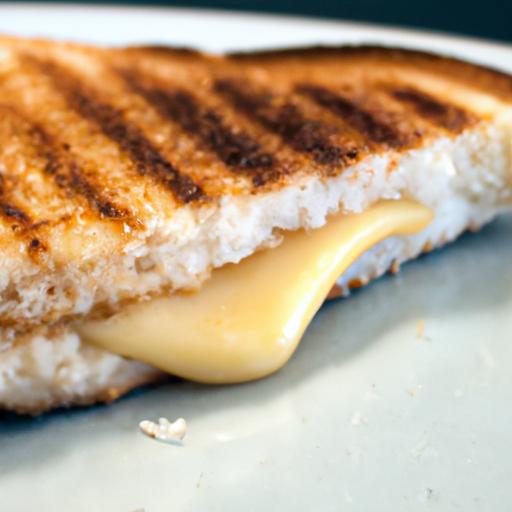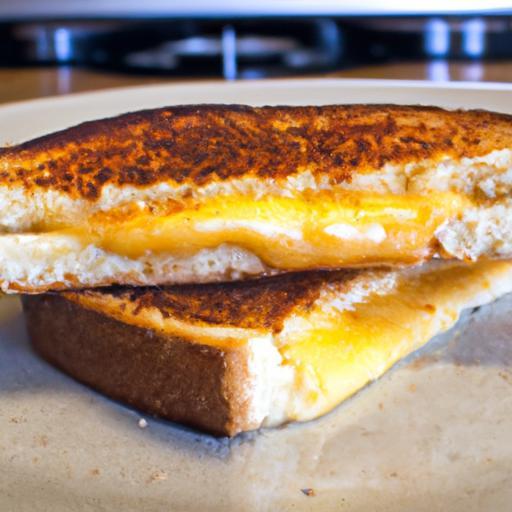There’s something undeniably magical about a perfectly grilled cheese sandwich-the golden, crispy exterior gives way to a molten, ooey-gooey center that instantly sparks joy with every bite. But achieving this nirvana of comfort food isn’t just luck or happenstance; it’s a delicious marriage of art and science. From the chemistry of melting cheese to the physics of heat transfer in your pan, understanding the science behind the ultimate perfect grilled cheese reveals why this humble sandwich holds a place as a culinary classic. Join us as we peel back the layers-both literally and figuratively-to explore how selecting the right ingredients, mastering the heat, and timing the grill conspire to create grilled cheese perfection.
Mastering the art of a grilled cheese sandwich transcends simple assembly and heat application; it beckons a deeper understanding of the science behind the ultimate perfect grilled cheese. At its core, this beloved comfort food relies on the fascinating chemistry of cheese – where moisture, fat, and protein interplay to create that ideal, stretchy melt. Paired with an expertly chosen bread variety, toasted with precision and balanced heat, you unlock a symphony of textures: a crisp, golden crust yielding to a lusciously gooey center. When thoughtfully paired with complementary flavors like tangy tomatoes or aromatic herbs, your grilled cheese evolves from nostalgic snack to gourmet experience.
Prep and Cook Time
- Preparation Time: 10 minutes
- Cooking Time: 8-10 minutes
- Total Time: 18-20 minutes
Yield
Serves 2 generously
Difficulty Level
Easy to Medium
Ingredients
- 4 slices artisan sourdough bread, about ½ inch thick
- 3 tbsp unsalted butter, softened
- 1½ cups shredded sharp white cheddar cheese
- ½ cup shredded Gruyère cheese
- 1 tsp Dijon mustard, optional
- 2 tsp finely chopped fresh thyme or rosemary
- 1 tbsp mayonnaise (for spreading, optional)
- Freshly ground black pepper, to taste
Instructions
- Preheat a skillet to medium-low heat. This gentle heat ensures even melting without burning the bread’s surface.
- Butter one side of each bread slice evenly. For a buttery crust, apply a thin, consistent layer about 1/8 inch thick.
- Optional: Spread mayonnaise or Dijon mustard on the unbuttered side of two slices for an added layer of tangy complexity.
- Layer the cheese: Combine sharp cheddar and Gruyère in a bowl. Evenly distribute the cheese mixture onto the mayo/mustard side of two slices. Sprinkle with fresh herbs and cracked black pepper to enhance the flavor palette.
- Sandwich assembly: Place the remaining bread slices on top, buttered side up, creating two sandwiches.
- Place sandwiches in skillet: Cook for about 4-5 minutes on one side without pressing. Resist the urge to flip too soon to promote a crunchy crust.
- Flip carefully using a thin spatula. Cook an additional 4-5 minutes until the second side is equally golden and the cheese has fully melted into a stretchy, gooey bliss.
- Test cheese melt: Peek inside by gently lifting the edge; the cheese should flow luxuriously. If not, reduce heat to low, cover the pan with a lid for 1-2 minutes, and check again.
- Remove from skillet and let rest for 1 minute before slicing diagonally. This brief pause allows residual heat to set the cheese slightly, preventing runs yet preserving softness.
Tips for Success
- Cheese chemistry matters: Combining a high-moisture melt like Gruyère with sharp cheddar’s bold flavor fosters a creamy melt and complex taste profile.
- Bread choice is crucial: Opt for rustic sourdough or artisan white bread with a tight crumb structure to support the cheese without becoming soggy.
- Low and slow wins: Medium-low heat lets cheese melt perfectly while bread crisps without burning, a key to ideal textures.
- Using a lid: Covering the skillet traps steam, facilitating uniform cheese melt while maintaining crisp bread exterior.
- Prep ahead: Assemble sandwiches and refrigerate on parchment for up to 2 hours to speed up dinner prep without compromising quality.
Serving Suggestions
Slice your grilled cheese into triangles and serve with a vibrant roasted tomato soup or a crisp green salad to contrast textures and balance richness. Garnish with a sprinkle of freshly chopped herbs or a drizzle of chili-infused honey for an unexpected but delightful accent. For an added crunch element, try pairing with dill pickles or a crunchy slaw. Capture the golden hues and gooey pull of your masterpiece by plating on rustic wooden boards or vintage enamel plates to elevate presentation and invite that nostalgic warmth.
| Nutrient | Per Serving |
|---|---|
| Calories | 520 kcal |
| Protein | 25 g |
| Carbohydrates | 45 g |
| Fat | 28 g |
To dive deeper into the ingredient selection and chemistry, check out our related article. For scientific insights on cheese melting behavior, visit the International Dairy Foods Association.

Q&A
Q&A: The Science Behind the Ultimate Perfect Grilled Cheese
Q1: What makes a grilled cheese sandwich truly “perfect”?
A1: The perfect grilled cheese is an alchemy of textures and flavors-crispy, golden-brown bread hugging delectably melty, gooey cheese in harmony. Science tells us the magic lies in the Maillard reaction, where heat transforms the bread’s natural sugars and proteins into a complex, savory crust. Meanwhile, the cheese melts just right, delivering that luscious stretch without turning oily or rubbery.
Q2: Why is the Maillard reaction important in grilling cheese sandwiches?
A2: The Maillard reaction is the secret sauce behind that irresistible browned crust. When your bread hits the hot pan, heat triggers this chemical dance between amino acids and reducing sugars, producing hundreds of flavor compounds. This not only deepens the taste but also gives grilled cheese its signature golden hue and delightful crunch.
Q3: How does the type of cheese affect the grilled cheese experience?
A3: Cheese choice is pivotal. Swiss, cheddar, mozzarella, Gruyère-they each bring different melting behaviors and flavor profiles. Good melting cheeses have the right moisture and fat content to soften smoothly without separating. For example, American cheese melts uniformly and creates that classic oozy texture, while aged cheddar provides sharper flavor but requires careful heat control to avoid greasiness.
Q4: What role does bread play beyond just being a holder?
A4: Bread is the foundation. Its texture, thickness, and crumb impact both flavor absorption and structural integrity. A sturdy, slightly porous bread like sourdough soaks up butter beautifully, encouraging even browning. Thin or super soft bread risks sogginess, while very thick slices may prevent even melting of the cheese inside.
Q5: Is butter or oil better for grilling the perfect grilled cheese?
A5: Butter reigns supreme for classic grilled cheese due to its rich flavor and ability to promote even browning. Its milk solids brown beautifully, enhancing the Maillard effect. Oil can be used but tends to create a less nuanced crust. Some chefs blend butter with a bit of oil to prevent burning while keeping that buttery taste intact.
Q6: What’s the ideal temperature and cooking time?
A6: Medium-low heat is the sweet spot. Too hot, and the bread burns before the cheese melts; too low, and you lose the satisfying crunch and golden color. Typically, 3-4 minutes per side allows the cheese to perfectly melt while the bread crisps up. Patience is key-rushing leads to uneven textures.
Q7: Can adding fillings or seasoning impact the science of grilled cheese?
A7: Absolutely! Add-ins like tomato, bacon, or herbs introduce moisture and textures that interact with melting dynamics. Moist ingredients require adjustments-like pressing the sandwich gently or using slightly thicker bread-to maintain structure. Seasonings like garlic powder or paprika can infuse layers of flavor without interfering with melting chemistry.
Q8: What’s a quick science tip for reviving leftover grilled cheese?
A8: To refresh a day-old grilled cheese, reheat it in a skillet with a lid on low heat. The lid traps steam, warming the cheese back to melty goodness, while the pan crisps the bread anew. Avoid the microwave, which often creates sogginess and uneven heating.
Q9: How has understanding the science improved grilled cheese recipes?
A9: Science demystifies grilling and melting, enabling home cooks to troubleshoot and perfect their sandwiches. Knowing how heat, moisture, and ingredients react leads to more consistent, delicious results and inspires creative riffs-whether it’s layering cheeses for flavor complexity or choosing bread that crisps without burning.
Q10: In one sentence, what’s the ultimate secret to the perfect grilled cheese?
A10: The ultimate secret is balancing heat and ingredients to craft a symphony of crunchy, golden bread and irresistibly gooey, flavorful cheese, all orchestrated by the science of browning and melting.
Future Outlook
As the golden crust crisps and the cheese melts to a gooey perfection, it’s clear that the ultimate grilled cheese is far more than just a simple sandwich. It’s a harmonious marriage of chemistry, physics, and a dash of culinary artistry-a delicious reminder that science isn’t confined to labs but sizzles vividly right on our stovetops. So next time you fire up the skillet, remember: every bubble, every browning edge, every stretch of melted cheese is a testament to the fascinating science that transforms humble ingredients into an iconic comfort food. Embrace the experiment, savor the process, and enjoy the mouthwatering result-because understanding the why behind the how only makes that perfect grilled cheese taste even better.


